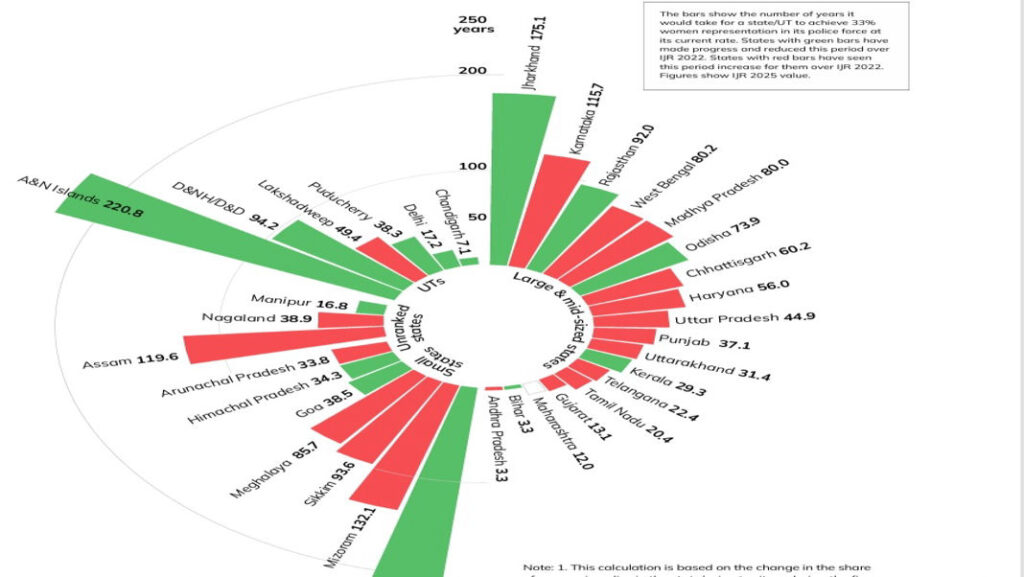Shillong, March 18: Despite national commitments to improving gender diversity in law enforcement, Meghalaya remains on an alarmingly slow path that sharply contrasts with its matrilineal tradition.
According to the India Justice Report 2025, if recruitment continues at the current pace, it would take the state approximately 86 years to achieve 33% representation of women in its police force.
This slow progress is especially stark when compared to other states. “Current rates remaining constant, Andhra Pradesh and Bihar would see 33% women in roughly three years. At around 200 years, it would take Jharkhand, Tripura and Andaman and Nicobar Islands several generations to meet this quota,” the report states. Assam would need around 120 years.

The India Justice Report (IJR), now in its latest edition, is the country’s only periodic, data-based ranking of states’ capacity to deliver justice. It relies exclusively on official government statistics and is a collaborative effort by DAKSH, Commonwealth Human Rights Initiative, Common Cause, Centre for Social Justice, Vidhi Centre for Legal Policy, and TISS-Prayas. The initiative is spearheaded by Tata Trusts.
In March 2025, the Meghalaya Legislative Assembly acknowledged the issue during its budget session.
MLA Mizanur Kazi raised concerns about women’s representation in the police force, prompting a response from Deputy Chief Minister Prestone Tynsong, who oversees Home (Police). Tynsong said plans are underway to induct a Women Police Sub-Inspector (WPSI) at the Rajabala Police Station after the ongoing recruitment round.
Currently, the Rajabala station has just two unarmed women constables, who are supported by personnel from nearby stations. The government reiterated its commitment to increasing female representation in the force.
However, concerns about gender disparity in Meghalaya’s police are not new. A 2013 report by North East Network (NEN), titled Rough Roads to Equality – Women Police in Meghalaya, had already flagged the issue. It recommended adopting a 33% reservation policy for women across all ranks as part of the Transparent Recruitment Process (TRP). It also pointed out that the Meghalaya Police Act of 2011 failed to ensure gender diversity.
The latest India Justice Report also highlights a dip in the state’s overall justice delivery performance, placing Meghalaya fifth among seven small states.
In the composite index, which aggregates performance across police, judiciary, prisons, and legal aid, Meghalaya scored 4.02 out of 10, ranking fifth. Sikkim and Himachal Pradesh continued to lead the category, while Meghalaya joined Mizoram and Goa in the bottom three. The state’s overall progress has fluctuated since the first report in 2019.
Breakdown by sector:
Police: Rank 5
Prisons: Rank 4
Judiciary: Rank 3
Legal Aid: Rank 5
The judiciary presents a mixed picture. While Meghalaya’s subordinate courts have shown a marginal improvement in clearing long-pending cases, the backlog remains substantial. As of January 2025, 36.7% of cases had been pending for over five years—a slight improvement from 37.3% two years earlier.
Even more concerning is the medium-term pendency, with over 51% of cases pending for more than three years, placing the state among the worst performers in this metric.
However, the Meghalaya High Court stands out for its efficiency. Over 91% of its cases are under five years old, and only 0.7% have been pending for over two decades, making it one of the best-performing high courts in the country.
On the legal aid front, all of Meghalaya’s prisons have functioning legal aid clinics, placing the state among a small group meeting this essential standard.
Gender Gaps Across the Justice System
Women in police: 5.8%
Women in prison staff: 16.1%
Women judges in High Court: 0%
Women judges in subordinate courts: 44.4%
As of 2023, the state averaged 1.3 women sub-inspectors and 7.7 women constables per police station. This falls short of the Ministry of Home Affairs (MHA) advisories, which recommend at least 3 sub-inspectors and 10 constables per station.

